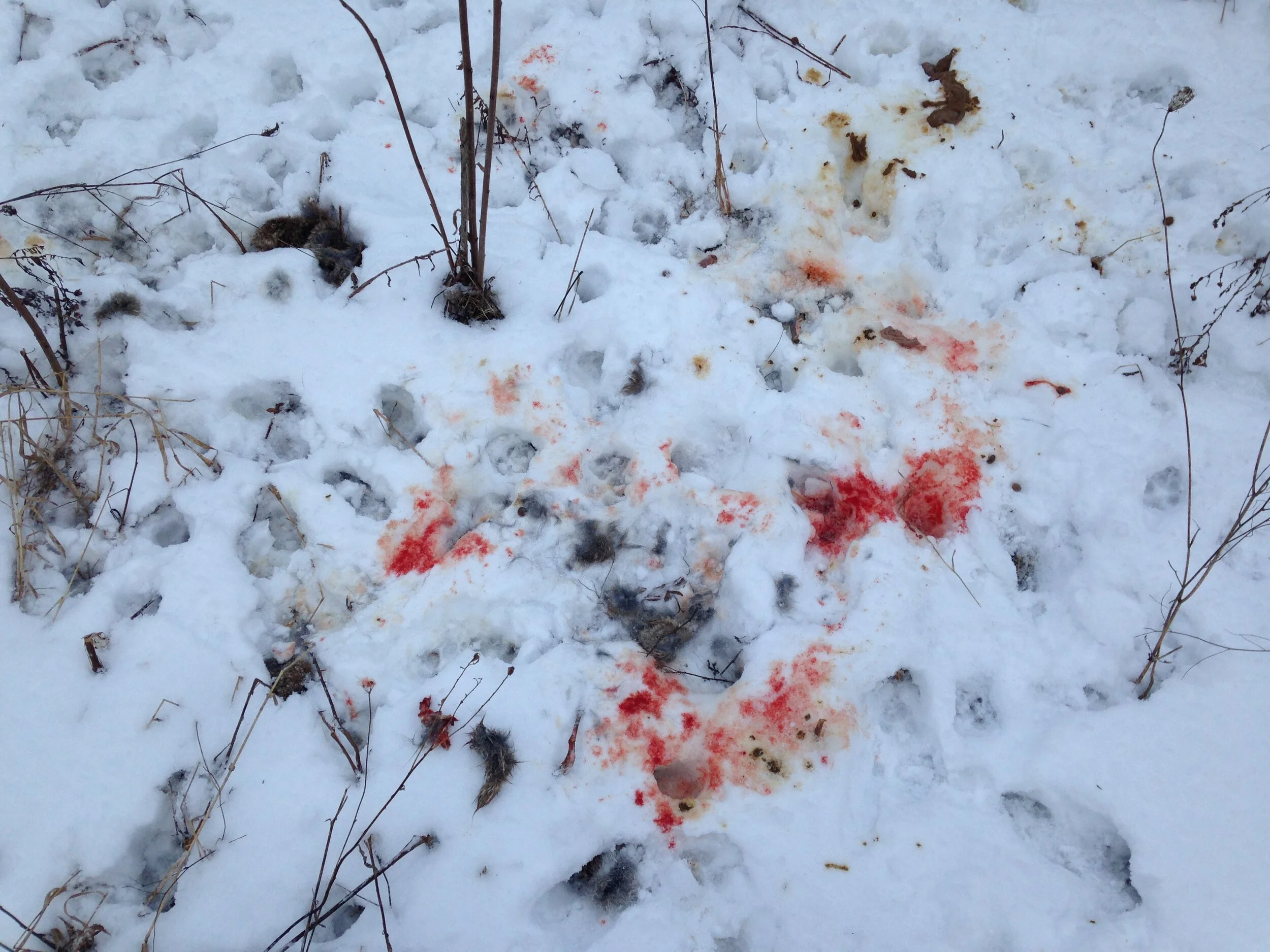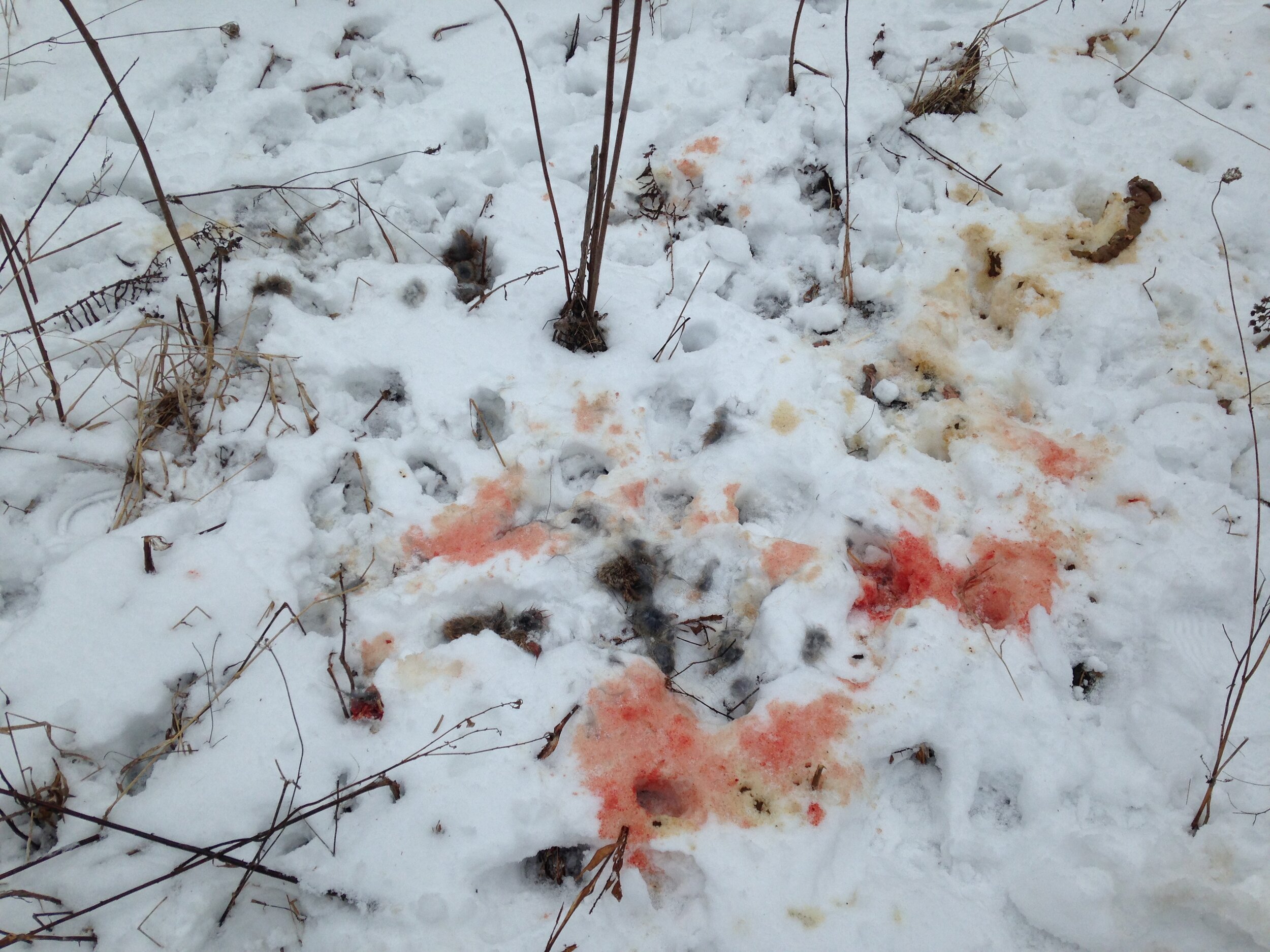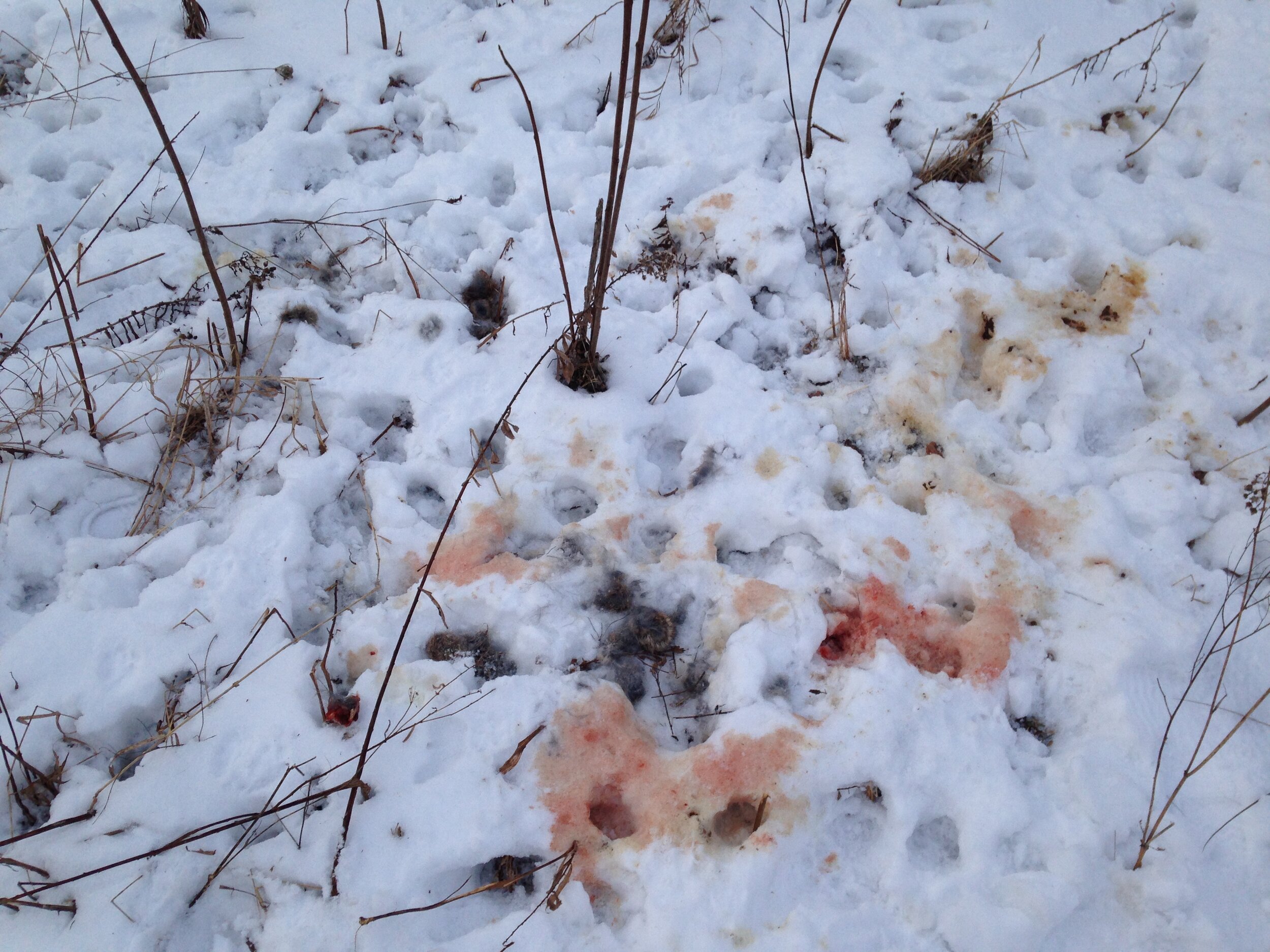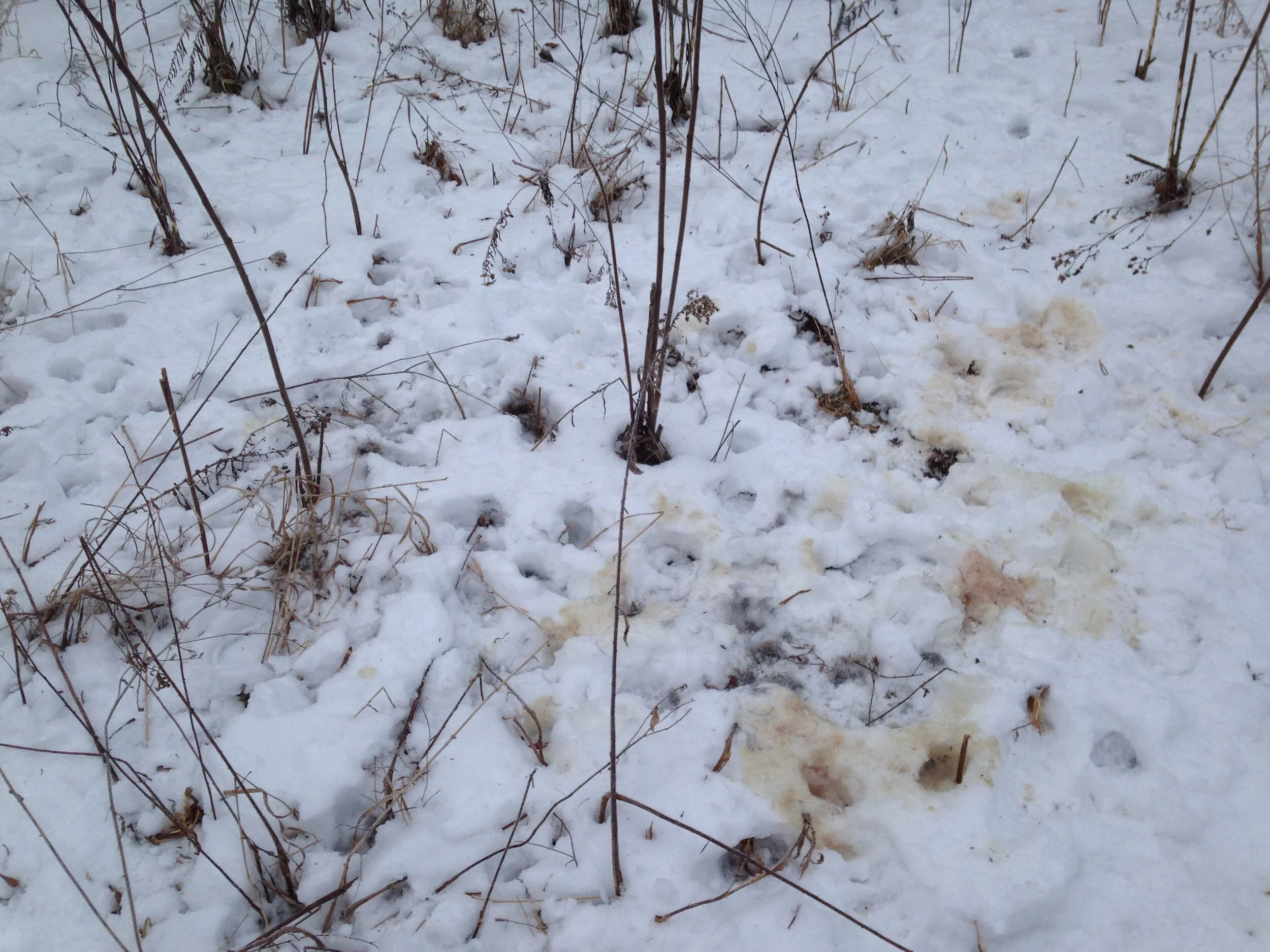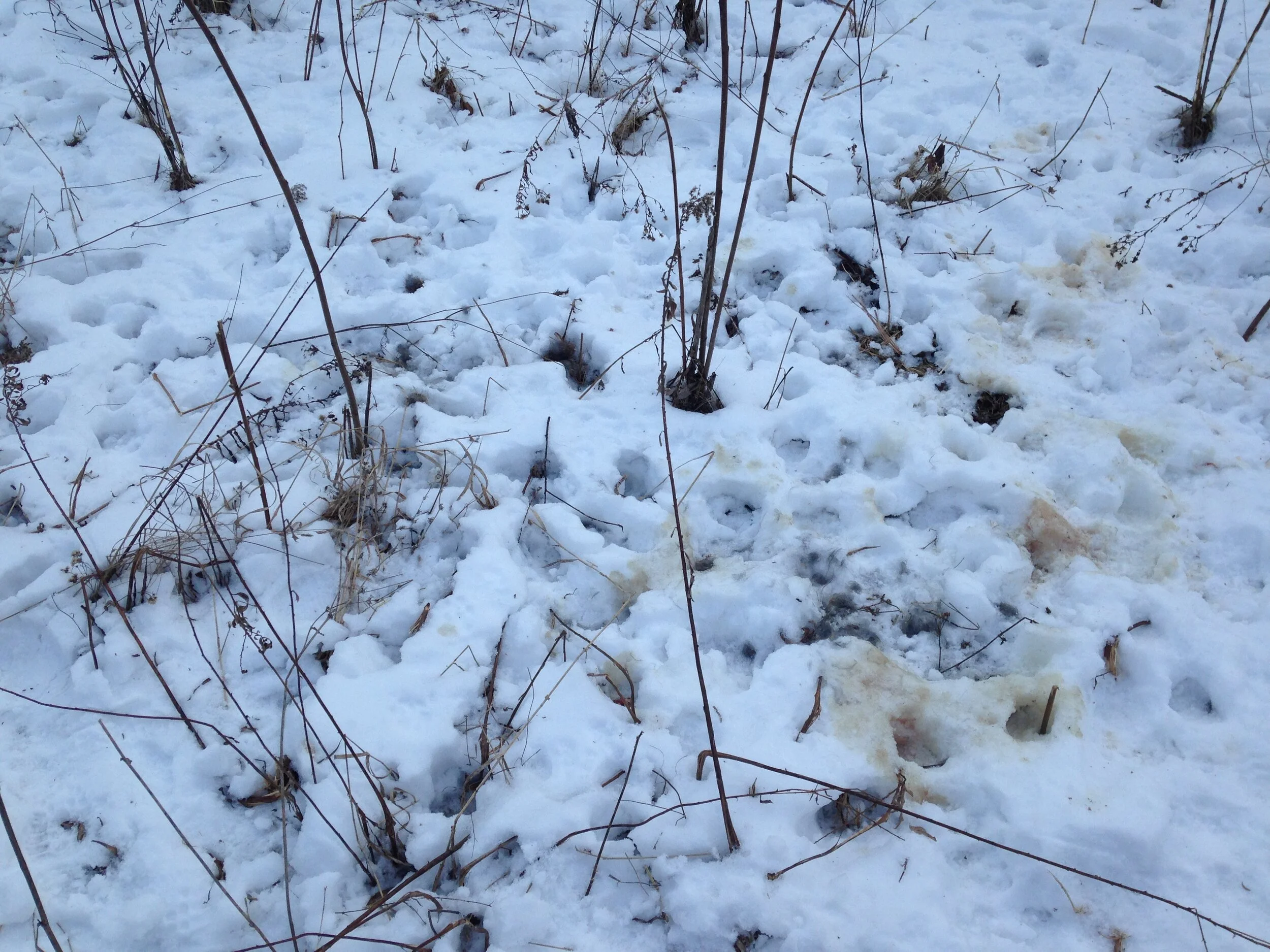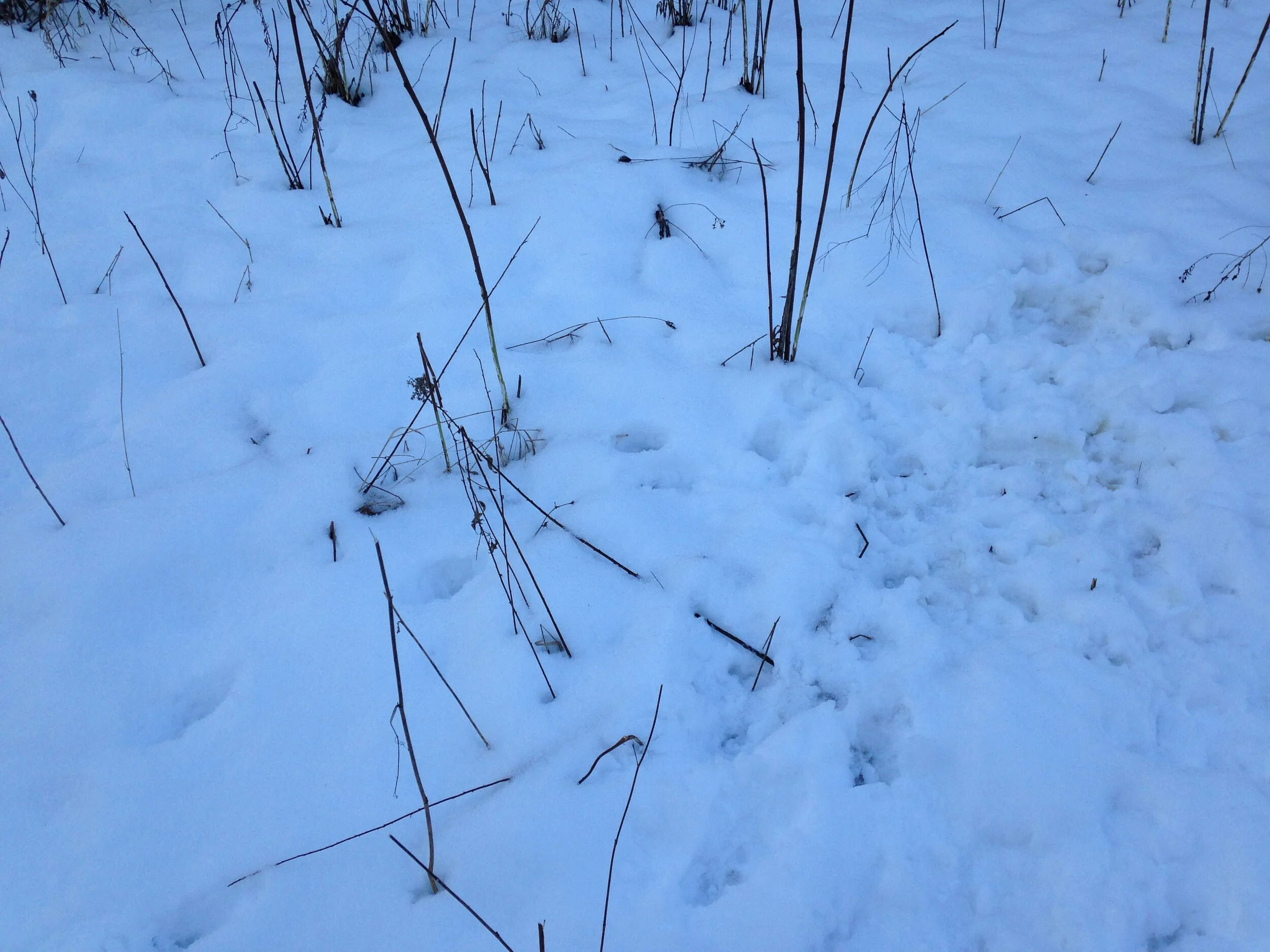Eastern Cottontail Rabbit killsite on the way to work
Where the killsite was found.
Below, is a work in trying to get better at detailed killsite analysis and aging. I wrote this last year for my personal journals, and am publishing it now because I think it is relevant and useful as I continue to come back to it to help understand Eastern Cottontails and Eastern Coyote predator/prey ecologies.
Before you begin, here is a suggested soundtrack to reading:
kyle bobby dunn - overture de peter hodge transport
stars of the lid - music for twin peaks episode #10
environmental mapping procedure - acetone
stars of the lid - december hunting for vegetarian fuckface
ian william craig - our loosening orbit
celer - there's no time to process
loscil - goat mountain
The Eramosa River Valley is a curving glacial valley formed by glacial retreat about 22,000-15,000 years ago. A river still flows through the bottom of it, the great granddaughter river of the one that cut the valley itself. Throughout the years a rail line, water pipeline, roadway, prison, slaughterhouse, Dolostone quarry, and city dump have been added to the valley slopes, or atop the hills on the landscape.
I take the same 30-40 minute (depending on the season and trail conditions) walk to work about 5 times a week on average. Some days I walk home after, sometimes I get a ride. Walking to work allows me to see the valley anew every morning as it is changing and being changed by the species that live within or pass through.
The Southern plateau, above the valley walls is now home to the Guelph Turfgrass Institute which contains test sites for longitudinal experiments on grasses, trees, and fungi. Wilder spaces have sprung up in the area within and adjacent to the 98 hectare Turfgrass lands. There, many species live and hunt, breed and die, part of a regenerating novel and complex ecosystem. This area is slated to be redeveloped into subdivisions within the next 3 years.
Tracks and blood stand out against the snow.
1. First sighting, Monday January 27th 2020, 8:33am
It had snowed about 3mm-4mm around 5pm the evening before, and the throughout the night it was hovering around -2°C, not too cold at all with a waxing crescent moon. It was probably overcast the whole way through the night so I’d imagine it would’ve been pretty dark if it weren't for the abattoir across the river.
I believe the Eastern Cottontail Rabbit (Sylvilagus floridanus) got got early in the morning of the 27th, but I can’t tell when exactly. I wish I had checked the scene for anything that might still be warm, though there was nothing obviously steaming.
The blood was still bright and vibrant when I took the photo. That’s what first caught my eye while walking by, the living red against the white. Tufts of brindly hair strewn about the edge of the Staghorn Sumac (Rhus typhina) grove, with lots of Rabbit pellets punctuating the bounding tracks through the snow.
I couldn’t make it all out with the short time I had but I have a feeling the Coyotes (Canis latrans) were coming from the Southeast, making their way Northwest. More wild spaces Eastwise, and the city was behind me to the West. The Coyote tracks are often headed Westwise, flowing with the river.
The caecum was spilling out barely formed pellets (upper left quadrant of the image) and there were odd bits of organ or meat of which I don't know their names.
No animal tracks led from the killsite towards the traintracks and nothing crossed the rails towards the cliff face as I imagined I would see. Maybe when headed West, the cliff just becomes a barrier, and things only open up going East?
Right mandible and a tuft of hair.
2. Right mandible, 27th, 8:33am.
In retrospect, I should have measured all I could and took notes and just spent more time than I did there. I could have documented this so much better. Let it be a push to do better next time.
When I looked down and saw this mandible I got really excited. I collect skulls and try to study them to understand individual species ecologies better, and despite how plentiful they are, and how many roadkill Rabbits I have been partial too, I have not gotten a skull. Mandibles still get me stoked.
I don’t remember seeing the left side which was obviously still there (see photo near the end), but I remember noting that the right mandible was intact up until the midway point, missing the posterior half. I am unsure of a name for the whole back half of the mandible which consists of the condyloid, coronoid and angular process, but it may be the ramus. It all looked a little gruesome, but it's also a good biology lesson.
Eastern Cottontail Rabbit stomach.
3. Stomach 27th, 8:33am.
Rabbit stomachs are considered large in the relation to their overall size. Their stomachs are not distensible, they cannot expand, like our stomachs can. Instead, their stomachs are designed to do the first round of processing, with acids and enzymes breaking plant materials down before passing those partly digested materials on to the small intestine where most minerals and nutrients are absorbed.
The left side of the image you can see a rumpled tube which is where the stomach connects to the duodenum (small intestine - gated by the pyloric sphincter). On the right side it looks as if a Coyote has gotten their teeth into the corner of the stomach and torn it open. The base of the esophagus, where it connects to the stomach, is tucked mostly out of sight in the photo but can still sort of be seen as a small tubular structure on the right side of the crease (here is housed the cardiac sphincter).
A brindley tuft of Rabbit hair.
4. Tufts of hair 27th, 8:33am.
One of these, the lower one on the right side of the image, wasn't actually a tuft of hair. It would be better described as a pelt. The Coyotes had peeled this piece off. I picked it up and it was pretty heavy so I had to pull it out to its full flesh without stretching it. It was about 18cm long x 10 or 11 cm wide. I had a thought that I would take it with me when I left and show the kids I work with and describe the scene to them, but when I walked away it felt wrong to be taking this piece of pelt without offering any respects or gifts to the Rabbit in return. It was too “vulture culture” for me. I ended up tucking the piece of pelt within the base of a copse of Buckthorn (Rhamnus cathartica) trunks along with an apple and a couple of songs of thanks and obligation to share/teach/learn through the observation of this killsite.
Faded blood, additional tracks.
5. Second sighting, Monday January 27th, 2:35pm. Probably about -1°?
I was out with some kids who didn't feel like doing a sit spot. I invited them to check out the kill site I had mentioned seeing on my walk in to work, but they didn't want to go. They weren't really convincing in their hesitation, but instead it seemed like they just wanted an excuse to keep sitting on the embankment beside the busy road, so I urged them on through a small Beavered wetland and then up the trail and eventually to the killsite anyhow. They were all enthused that we’d made it there in such little time (maybe they thought it was a lot further than it was?). Some were excited by the prospect of Coyotes being so close to the school, while others just thought the blood was cool.
I could see how the blood had already began to fade and the vibrancy of the morning was dimming. Was it that the day was warming or that the water in the snow was diluting blood, or was it some sort of oxidizing process? What is it that changes the colour of the blood on the snow?
The mandibles had been moved, but I couldn't remember if it was me or not...
As we began to walk back to the school I went to check on the pelt I had stashed earlier in the Buckthorns. The fur was gone and there were what appeared to be domestic Dog tracks leading up to and away from the small bunch of Buckthorns.
Blood changed colour, even more additional tracks, and a new discovery.
6. Third sighting, Tuesday January 28th, 2020, 7:39am.
I was really grateful to B.Rose for giving me an old phone of hers so I could use it as a camera. My previous one I had recently gotten from Freecycle had suddenly stopped working for unknown reasons, and I was sad I couldn’t be taking photos of my tracking adventures. She ended up driving into town and dropped off the phone/camera at my house so I could continue to document all that I was seeing. I owe her immensely.
The morning was exciting as I knew I would be taking a photo of the killsite as I walked by. I leave the house pretty early as I walk to work and it takes a while to get there. I was worried that the light would be too dim and I wouldn’t get a good shot, but really I didn’t notice if much had changed much over night.
I noticed later in the day when I went back to the site that the caecum was no longer there and that a couple spots of blood out of the top of the frame were still fairly red, similar to the darker meatier reds in the lower right quadrant of the photo. Perhaps the coyotes had dragged something over there that was bloodier? There was no body print where they may have laid down to chew something, and not as many tracks as in the core of the site, but I wish I had spent more time exploring that spot.
I crossed the railroad tracks to keep an eye on the kids after they were bored of the killsite and had crossed the rails themselves. I was looking in the snow to see what I could see, which was mostly Rabbit, Red Squirrel (Tamiasciurus hudsonicus), a Raccoon (Procyon lotor), and what seemed to be a Long Tailed Weasel (Mustela frenata). The trail was erratic and not so orderly, and felt like not a lot of weight, but the trail width seemed to fit the notes I had for a Long Tail. When my co-worker came to the railroad saying she was ready to go, she also mentioned that she had found some Weasel scat around the kill site (just beyond the upper left corner of the photo). I asked her where and barely stayed long enough to hear what she said before running off back to the killsite.
I still couldn't find the Weasel scat in the mess of Coyote tracks by the time she came back over to see what I thought. She pointed the scat out and I investigated and took measurements (and now wish I took a photo). From the scat measurements (~1cm diameter, and <10cm in length) I was feeling pretty sure it was a Long Tail. Perhaps they had come in the night to pick at any small remains, or just to tag the spot to let everyone know he was there. The kids didn’t care about the Weasel.
Signs starting to melt and disappear.
7. Fourth sighting, Wednesday January 29th, 2020, 7:30am. Around -5°.
It was colder the night of the 28th-29th than it had been for a week. Most of the crisp tracks in the shallow snow I first saw on Monday were gone, stepped on or drove over, and most of the blood from the killsite was unrecognizable as such. It just looked like the Rabbits were eating a lot of Buckthorn berries and shitting them out, or all the Dog walkers were getting their Dogs to piss in the same spot.
The stomach was now missing and I couldn't find the mandibles. There were still the occasionally wispy tuft of hair, but it was feeling a little thin, like the energy of the space was dissipating.
Less and less to be seen and the energy is dissipating.
8. Fifth sighting, Wednesday January 29th, 12:27pm. Around -2°.
The kids just wanted to knock the icicles off of the cliff walls across the tracks from the killsite so I let them do their thing while I went back to get a photo. It really felt like the spectre of death, or the burst of life was dwindling or even already departed from the site, but it felt important to continue to document in case anything else came up.
We did spook Screamer though; Screamer being the collective name for the two Red Tailed Hawks (Buteo jamaicensis) who live in the valley. Only one of them this time, spiraled above us a few times as I called out i.d. features hoping the kids would take note. I wonder if Screamer had been scoping out the remains looking for a snack, or watching to see if any Mice (Peromyscus spp.) or Voles (Microtus spp. and Myodes spp.) would wander through. Don't the Mice and Voles occasionally eat carrion? I never saw any of their tracks, nor the Red Tails, but perhaps that's just my skills not being up to par.
New questions in the aftermath.
9. Sixth sighting, Thursday January 30th, 2020, 7:43am.
Nothing to note really, but I often wondered what Dog owners thought as they walked by with their Dogs? Or the joggers? Did anyone snitch about Coyote activity to the city? Would anyone at the city really care? Could anyone even tell it was a killsite anymore? If so, did they care? Was anyone in wonder or awe about it? Was anyone else watching closely?
Both mandibles sunk into the snow.
10. Both mandibles
I did find the mandibles again, fallen into a track, and this is also when I realized that the two were together still, and that it wasn't just the right side (I should pick up the pieces more next time, hold them and explore them more so I don't miss anything). The Rabbit incisors are so damned sharp I wonder if that was why no one had eaten them? I have also heard that Eastern Cottontails have two rows of incisors but I can't seem to find them in the photos... Perhaps they are only on the top incisors and not on the bottoms? Another good reason to collect and examine a decent skull.
Life continues. Death is come to other places.
11. Seventh sighting, 30th, 4:18pm.
It was about -3° at the time this photo was taken. I hadn’t taken the kids as we went in the other direction that day and found a Raccoon skull, and later, a White-Tailed Deer (Odocoileus virginianus) leg in the railroad side corner of Turkey Woods as entered by old cornfield.
I was on my way home when I ran into a pal and her kids. They had just walked by the killsite not even noticing it and I realized that this would be the last photo I took. The spirit had left, and more snow was on the way to cover and conceal the rest of whatever remained.
Final sighting, only Dog tracks.
12. Eighth sighting, February 3rd, 2020, 8:33am
Only domestic Dog tracks when I got there Monday morning. The snow came over the weekend and everything got covered. Perhaps I'll see it again when it all melts. I wonder what the Meadow Voles (Microtus pennsylvanicus) will take? I wonder if the birds will take the Rabbit fur for their nests? Or will the Voles take that too?
Thanks for reading this one. It was a lot of fun to keep track.


